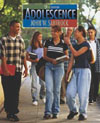John W. Santrock,
University of Texas, Dallas
| acculturation | Cultural change that results from continuous, first-hand contact between two distinctive cultural groups.
|
 |
 |
 |
| alternation model | This model assumes that it is possible for an individual to know and understand two different cultures. It also assumes that individuals can alter their behavior to fit a particular social context.
|
 |
 |
 |
| assimilation | The absorption of ethnic minority groups into the dominant group, which often means the loss of some or virtually all of the behavior and values of the ethnic minority group.
|
 |
 |
 |
| Chicano | The name politically conscious Mexican American adolescents give themselves, reflecting the combination of their Spanish-Mexican-Indian heritage and Anglo influence.
|
 |
 |
 |
| cross-cultural studies | Studies that compare a culture with one or more other cultures. Such studies provide information about the degree to which adolescent development is similar, or universal, across cultures, or about the degree to which it is culture specific.
|
 |
 |
 |
| culture | The behavior, patterns, beliefs, and all other products of a particular group of people that are passed on from generation to generation.
|
 |
 |
 |
| e-mail | Stands for electronic mail and is a valuable way the Internet can be used. Written messages can be sent to and received by individuals as well as large numbers of people.
|
 |
 |
 |
| ethnicity | A dimension of culture based on cultural heritage, nationality, race, religion, and language.
|
 |
 |
 |
| ethnocentrism | A tendency to favor one's own group over other groups.
|
 |
 |
 |
| feminization of poverty | The fact that far more women than men live in poverty. Likely causes are women's low income, divorce, and the resolution of divorce cases by the judicial system, which leaves women with less money than they and their children need to adequately function.
|
 |
 |
 |
| Internet | The core of computer-mediated communication. The Internet is worldwide and connects thousands of computer networks, providing an incredible array of information adolescents can access.
|
 |
 |
 |
| multicultural model | This model promotes a pluralistic approach to understanding two or more cultures. It argues that people can maintain their distinctive identities while working with others from different cultures to meet common national or economic needs.
|
 |
 |
 |
| prejudice | An unjustified negative attitude toward an individual because of her or his membership in a group.
|
 |
 |
 |
| rites of passage | Ceremonies or rituals that mark an individual's transition from one status to another, especially into adulthood.
|
 |
 |
 |
| socioeconomic status (SES) | A grouping of people with similar occupational, educational, and economic characteristics.
|



 2003 McGraw-Hill Higher Education
2003 McGraw-Hill Higher Education

 2003 McGraw-Hill Higher Education
2003 McGraw-Hill Higher Education